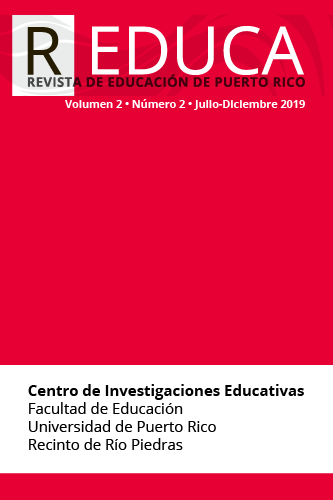Abstract
This conceptual paper responds to the question: What are some programs and practices that help or support educators in becoming more culturally responsive in their classrooms? Several culturally responsive practices and activities, and one culturally responsive program will be discussed: cultural autobiographies, "I am from…" poems, "Cultural Bags," and Generating Expectations for Student Achievement program (GESA).
References
Banks, J. A. (2012). Encyclopedia of diversity in education, 1-4. Thousand Oaks, CA: Sage Publications.
Brisk, M. E. (1998). The transforming power of critical autobiographies. Paper presented at the 32nd Annual Meeting of the Teachers of English to Speakers of Other Languages, Seattle, WA, March 17-21.
Campos, D. (2013). Educating Latino boys: An asset-based approach. Thousand Oaks, CA: Corwin.
Christensen, L. (1998). Where I'm From: Inviting student lives into the classroom. Rethinking Schools On Line, 12(2), 22-23.
Delgado-Gaitan, C., & Trueba, H. (1991). Crossing cultural borders: Education for immigrant families in America. London: Falmer Press.
Fuller, B., Kim, Y., Galindo, C., Bathia, S., Bridges, M., Duncan, G. J., & García Valdivia, I. (2019). Worsening school segregation for Latino children? Educational Researcher, 20(10), 1-14. DOI: https://doi.org/10.3102/0013189X19860814
Gandara, P. (2009). The Crisis in the Education of Latino Students. Retrieved from http://www.nea.org/home/17404.htm
Gay, G. (2018). Culturally responsive teaching: Theory, research, and practice (3rd ed.). New York: Teachers College Press.
Good, T. L., & Brophy, J. E. (2007). Looking in classrooms (10th ed.). London, England: Pearson.
Grayson, D. A., & Martin, M. D. (2012). Generating expectations for student achievement (GESA): An equitable approach to educational excellence. Tehachapi, CA: GrayMill.
Harris, M. Y. (2005). Black women writing autobiography: Autobiography in multicultural education. In J. Phillion, M. F. He, & F. M. Connelly (Eds.), Narrative and experience in multicultural education (pp. 36-52). Thousand Oaks, CA: Sage Publications.
Hess, K. K., Jones, B. S., Carlock, D., & Walkup, J. R. (2009). Cognitive rigor: Blending the strengths of Bloom‘s taxonomy and Webb‘s depth of knowledge to enhance classroom-level processes. (ERIC Document Reproduction Service No. ED 517804). Retrieved from http://files.eric.ed.gov/fulltext/ED517804.pdf
Hollins, E. R. (1996). Culture in school learning: Revealing the deep meaning. Mahwah: Lawrence Erlbaum Associates.
Howard, G. R. (2016). We can‘t teach what we don‘t know: What teachers, multiracial schools (3rd ed.). New York: Teachers College Press.
Jones, F. (2000). Tools for teaching: Discipline, instruction, motivation. Santa Cruz, CA: Fredric H. Jones & Associates.
Kelly, M. (2019). Question stems for each level of Bloom‘s taxonomy. Retrieved from https://www.thoughtco.com/blooms-taxonomy-questions-7598
Kohn, A. (2001). Five reasons to stop saying "Good Job!" Young Children, 56(5), 24-28. Retrieved from https://www.alfiekohn.org/article/five-reasons-stop-saying-good-job/
Ladson-Billings, G. (2009). Dreamkeepers: Successful teachers for African American children. (2nd ed.). San Francisco, CA: Jossey-Bass.
Li, X. (2007). Multiculturalize teacher identity: A critical descriptive narrative. Multicultural Education, 14(4), 37-44. Retrieved from http://files.eric.ed.gov/fulltext/EJ774721.pdf
Marquez Chisholm, I. (1994). Preparing teachers for multicultural classrooms. The Journal of Educational Issues of Language Minority Students, 14, 43-68.
Marrero, F. A. (2016). Barriers to School Success for Latino Students. Journal of Education and Learning, 5(2), 180-186. DOI: https://doi.org/10.5539/jel.v5n2p180
Maxwell, L. A. (2014, May 20). Latino students are nation‘s most segregated, report finds. Education Week, 33(32), 6. Retrieved from https://www.edweek.org/ew/articles/2014/05/21/32deseg.h33.html
National Center for Education Statistics (NCES). (2017) The Condition of Education: Status Dropout Rates. Washington, D.C.: National Center for Education Statistics, Institute of Education Sciences, U.S. Department of Education. Retrieved from https://nces.ed.gov/programs/coe/indicator_coj.asp
National Center for Education Statistics (NCES). (2019). Status and Trends in Education of Racial and Ethnic Groups. Washington, D.C.: National Center for Education Statistics, Institute of Education Sciences, U.S. Department of Education. Retrieved from https://nces.ed.gov/programs/raceindicators/index.asp
Nieto, S. (2000). Affirming diversity: The Sociopolitical Context of Multicultural Education (3rd ed.). New York: Longman.
Nieto, S. (2010). Language, culture, and teaching. Critical perspectives (2nd ed.). New York: Routledge.
Nieto, S., & Bode, P. (2012). Affirming diversity: The sociopolitical context of multicultural education (6th ed.). Boston, MA: Pearson.
Ovando, C. J., & Combs, M. C. (2012). Bilingual and ESL classrooms: Teaching in multicultural contexts (5th ed.). New York, NY: McGraw Hill.
Pals, T., & Boylin, C. (2019, July 30). School segregation worsens for Latino children compared with a generation ago. American Educational Research Association. Retrieved from https://www.eurekalert.org/pub_releases/2019-07/aera-ssw072919.php
Park, G. (2011). Adult English language learners constructing and sharing their stories and experiences: The cultural and linguistic autobiography writing project. TESOL Journal, 1(2), 156-172. DOI: http://dx.doi.org/10.5054/tj.2011.250378
Phillion, J., He, M. F., & Connelly, F. M. (Eds.). (2005). Narrative and experience in multicultural education. CA: Sage Publications.
Santamaria, L. J. (2009). Culturally responsive differentiated instruction: Narrowing gaps between best pedagogical practices benefiting all learners. Teachers College Record, 111(1), 214–247.
Slavin, R. E., & Calderon, M. (2001). Effective Programs for Latino Students. New Jersey: LEA Publishers.
Slavin, R. E. (2014). Making cooperative learning powerful. Educational Leadership, 72(2), 22-26. Retrieved from http://www.ascd.org/publications/educational-leadership/oct14/vol72/num02/Making-Cooperative-Learning-Powerful.aspx
Spindler, G., & Spindler, L. (Eds.). (1994). Pathways to cultural awareness: Cultural therapy with teachers and students. Thousand Oaks: Corwin Press.
Sadker, D., & Sadker, M. (1985). Is the O.K. Classroom O.K.? Phi Delta Kapan, 66(5), 358-361.
United States Census Bureau. (2018, Sep. 13). Hispanic Heritage Month 2018. Retrieved from https://www.census.gov/newsroom/facts-for-features/2018/hispanic-heritage-month.html
United States Department of Education. (2016). The State of Racial Diversity in Educator Workforce. Retrieved August 1, 2019 from https://www2.ed.gov/rschstat/eval/highered/racial-diversity/state-racial-diversity-workforce.pdf
Valenzuela, A. (1999). Subtractive schooling: U.S.-Mexican youth and the politics of caring. Albany, NY: State University of New York.
Wentzel, K. R. (1997). Student motivation in middle school: The role of perceived pedagogical caring. Journal of Educational Psychology, 89(3), 411-419. DOI: http://dx.doi.org/10.1037/0022-0663.89.3.411
The contents published in the Puerto Rico Journal of Education is freely distributed under open access practices, in accordance with the Creative Commons license, Attribution-NonCommercial 4.0 International (CC BY-NC 4.0). Through these principles, the journal and its authors allow readers to access, reproduce and share articles in full text. Users should give credit to authors in a reasonable way without suggesting they have their support. Under no circumstances, readers may make use of the contents for commercial purposes. The authors retain copyright on their works.

